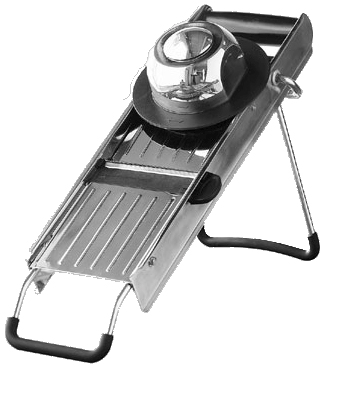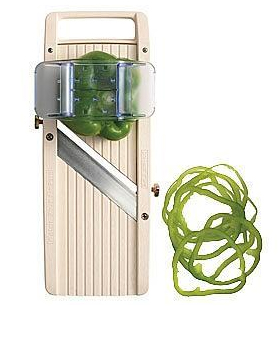Note: Between now and January 1, we’re going to write about ten of our favorite things (in no particular order), from 2009.
There is no culinary language more seductive than French. Consider that most basic of edible tubers, what the Germans call Kartoffel, the Italians and Spanish patata, and we know as the potato. A homely name for a drab vegetable. Except in France. Where it is lovingly referred to as a pomme de terre—an apple of the ground. And what do the French do with these “apples of the ground?” Why they coif and rouge the little beauties, dressing the country bumpkins up as gratin dauphinois—what we unimaginatively call scalloped potatoes. Or they soak and press the little darlings into pommes Anna, a buttery potato cake with a luscious crispy crust.
The secret to most French potato dishes—from gaufrettes to gratins—is another creatively named Galic wonder, the mandoline. No one really knows who invented or named the mandoline. Manual vegetable slicers, made out of blocks of wood with a sharp blade in the middle, have been around for hundreds of years, but the first metal version was made by Jean Bron, a manufacturer from the Haute-Savoir region of southern France, in the early 50s. Like Edith Piaf, the Bron mandoline became a French classic because it is proletarian in a haughty sort of way. Every French chef has a mandoline. And respects it like an elderly relative.
One of my favorite chefs, Gregory Short, remembers first coming across a mandoline while studying at the Culinary Institute of America in Hyde Park, New York. “I had a French instructor who was so adamant about the care of the mandoline that you had to sign it out before you could even use it,” he says. But the hassle was worth it, particularly when Short had to prepare something like Vichy carrots or thinly sliced celery root.
Its efficacy wasn’t lost on the young chef when he went to work at Napa Valley’s legendary French Laundry. “I watched other chefs do things with knives that were really just a waste of time,” he says. “They’d be making very fine, tedious cuts that could actually be better done using a mandoline.”
Mostly I use a somewhat expensive stainless steel French mandoline but I also get a kick out of using an inexpensive Japanese model, Benriner, because it’s lighter and easier to clean. Plus it gives you the flexibility to shave very thinly sliced vegetables right over the dish.
While almost all mandolines are designed with cutting guards to protect fingers from being thinly sliced, I seldom use it. Sometimes I’ll hold the vegetable with a towel but usually I’ll just use my fingers to push the vegetables through—and try to be careful.
Très, très prudent .
Tags: Favorite Things



Recent Comments